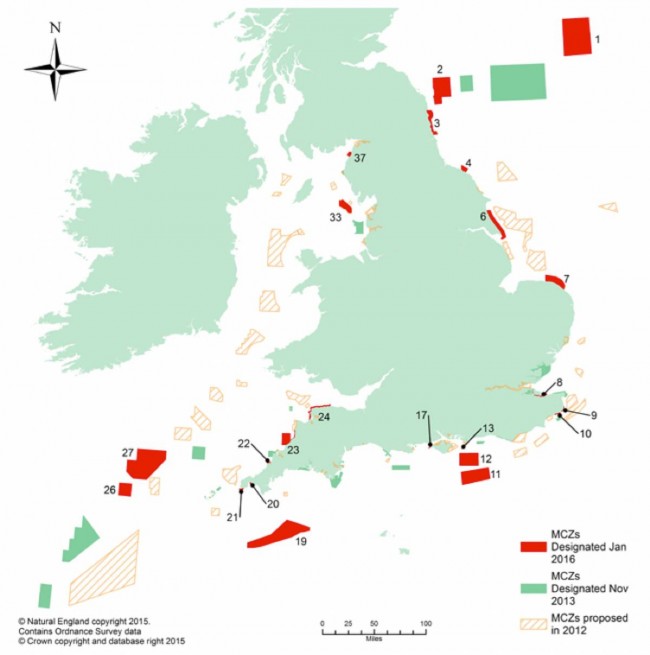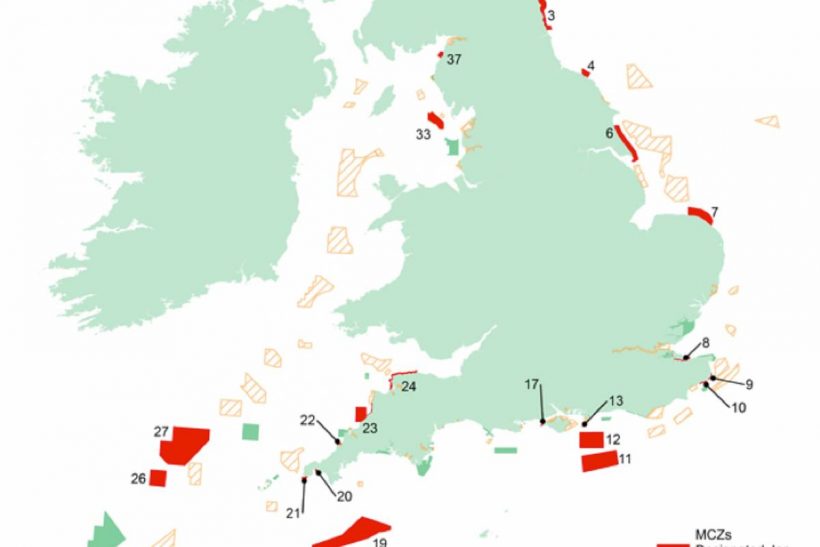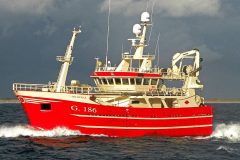DEFRA has designated another 23 marine conservation zones (MCZs) in English waters, reports Tim Oliver
They will bring the total number of MCZs to 50, and cover more than 7,886sq miles. This is more than a fifth of English waters and is an area roughly equivalent to the whole of Wales, or 13 times the size of Greater London.
A consultation on the sites was carried out early in 2015.
The new MCZs will cover areas from as far north as Farnes East off the coast of Northumberland, down to Land’s End. DEFRA says they will protect 45 different types of habitat, geological features and species such as stalked jellyfish and spiny lobsters.
Announcing the new sites, fisheries and marine environment minister George Eustice said it was vital to protect the marine environment to ensure the seas remain healthy, and the fishing industry remains prosperous.
“By designating these new MCZs and creating a ‘blue belt’ of protected areas around the country, we can better protect our environment through careful marine management in years to come.”
The NFFO welcomed the fact that DEFRA is taking a gradual approach to designating the MCZs. Chief executive Barrie Deas said: “I am pleased that DEFRA has moved away from the rushed timetable that had characterised the early stages of planning for the network of MCZs.
“Ultimately it’s the management measures to protect vulnerable features within MCZs that count, and this will need to be based upon an effective evidence-based approach. We have to find ways that provide adequate protection for features and habitats, while minimising their impact on fishing activities – remembering that these are people’s livelihoods we are talking about, and that fishermen put food on the table.”
He said experience had shown that achieving the support of people who relied on the local resources was critical to the success of MCZs, especially in times of tight public finances when monitoring would be necessarily limited.
“A measured, careful approach also limits the potential of the displacement of fishing and other activities that can actually do more harm than good, by having higher environmental impacts elsewhere if site locations and management measures are not planned properly.
“It’s for these reasons that government should continue to be cautious about what further sites it designates as part of the network.”
A number of campaign groups also welcomed the announcement; Joan Edwards, The Wildlife Trusts’ head of Living Seas, said the designation of 50 MCZs to date was ‘a strong step forward, but there is much still to do. It is vital that appropriate management is implemented as soon as possible’.
Dr Jean-Luc Solandt from the Marine Conservation Society said the MCZs don’t go far enough. He told Sky News: “We should eliminate trawling and dredging if we can, also aggregate extraction. Ports and harbours should be sympathetic in their dredging.”
The 23 additional sites are the second of three planned phases of MCZs. A third phase of proposed sites will be put out to consultation in 2017 and designated in 2018.

Map showing existing and new MCZs in English waters.
1 Fulmar, 2 Farnes East, 3 Coquet to St Mary’s, 4 Runswick Bay / Boulby, 6 Holderness Inshore, 7 Cromer Shoal Chalk Beds, 8 The Swale Estuary, 9 Dover to Deal, 10 Dover to Folkestone, 11 Offshore Brighton, 12 Offshore Overfalls, 13 Utopia
Protecting birds and porpoises
While the NFFO welcomed the gradual phasing-in of the MCZs, it questioned DEFRA’s announcement of new consultations on Special Areas of Conservation (SACs) for harbour porpoises.
NFFO chief executive Barrie Deas said: “We question the rationale for SACs for harbour porpoise. The scientific evidence shows that populations of harbour porpoise already hold a favourable status, and the general view is that these kind of sites can only provide very limited protection, if any, for a species like porpoise that migrate across very large distances.
“In such cases we have to ask: does this represent a good use of public finances, when there are more pressing needs for finite government resources in sustainably managing our seas?”
DEFRA will also be consulting on Special Protection Areas (SPAs) to protect feeding and bathing areas used by birds such as spoonbills in Poole Harbour and puffins on the Northumberland coast.
The consultation is expected to be launched later this month. The proposed areas will add to the 37 SACs and 43 SPAs already designated in English waters.
The 23 MCZs
■ North Sea: Fulmar, Farnes East, Coquet to St Mary’s, Runswick Bay, Holderness Inshore, Cromer Shoal Chalk Beds
■ South East: The Swale Estuary, Dover to Deal, Dover to Folkestone, Offshore Brighton, Offshore Overfalls, Utopia, The Needles
■ South West: Western Channel, Mount’s Bay, Runnel Stone, Newquay and The Gannel, Hartland Point to Tintagel, Bideford to Foreland Point, North-West of Jones Bank, Greater Haig Fras
■ Irish Sea: West of Walney, Allonby Bay
Read more from Fishing News here.


DEFRA has designated another 23 marine conservation zones (MCZs) in English waters, reports Tim Oliver
They will bring the total number of MCZs to 50, and cover more than 7,886sq miles. This is more than a fifth of English waters and is an area roughly equivalent to the whole of Wales, or 13 times the size of Greater London.
A consultation on the sites was carried out early in 2015.
The new MCZs will cover areas from as far north as Farnes East off the coast of Northumberland, down to Land’s End. DEFRA says they will protect 45 different types of habitat, geological features and species such as stalked jellyfish and spiny lobsters.
Announcing the new sites, fisheries and marine environment minister George Eustice said it was vital to protect the marine environment to ensure the seas remain healthy, and the fishing industry remains prosperous.
“By designating these new MCZs and creating a ‘blue belt’ of protected areas around the country, we can better protect our environment through careful marine management in years to come.”
The NFFO welcomed the fact that DEFRA is taking a gradual approach to designating the MCZs. Chief executive Barrie Deas said: “I am pleased that DEFRA has moved away from the rushed timetable that had characterised the early stages of planning for the network of MCZs.
“Ultimately it’s the management measures to protect vulnerable features within MCZs that count, and this will need to be based upon an effective evidence-based approach. We have to find ways that provide adequate protection for features and habitats, while minimising their impact on fishing activities – remembering that these are people’s livelihoods we are talking about, and that fishermen put food on the table.”
He said experience had shown that achieving the support of people who relied on the local resources was critical to the success of MCZs, especially in times of tight public finances when monitoring would be necessarily limited.
“A measured, careful approach also limits the potential of the displacement of fishing and other activities that can actually do more harm than good, by having higher environmental impacts elsewhere if site locations and management measures are not planned properly.
“It’s for these reasons that government should continue to be cautious about what further sites it designates as part of the network.”
A number of campaign groups also welcomed the announcement; Joan Edwards, The Wildlife Trusts’ head of Living Seas, said the designation of 50 MCZs to date was ‘a strong step forward, but there is much still to do. It is vital that appropriate management is implemented as soon as possible’.
Dr Jean-Luc Solandt from the Marine Conservation Society said the MCZs don’t go far enough. He told Sky News: “We should eliminate trawling and dredging if we can, also aggregate extraction. Ports and harbours should be sympathetic in their dredging.”
The 23 additional sites are the second of three planned phases of MCZs. A third phase of proposed sites will be put out to consultation in 2017 and designated in 2018.

Map showing existing and new MCZs in English waters.
1 Fulmar, 2 Farnes East, 3 Coquet to St Mary’s, 4 Runswick Bay / Boulby, 6 Holderness Inshore, 7 Cromer Shoal Chalk Beds, 8 The Swale Estuary, 9 Dover to Deal, 10 Dover to Folkestone, 11 Offshore Brighton, 12 Offshore Overfalls, 13 Utopia
Protecting birds and porpoises
While the NFFO welcomed the gradual phasing-in of the MCZs, it questioned DEFRA’s announcement of new consultations on Special Areas of Conservation (SACs) for harbour porpoises.
NFFO chief executive Barrie Deas said: “We question the rationale for SACs for harbour porpoise. The scientific evidence shows that populations of harbour porpoise already hold a favourable status, and the general view is that these kind of sites can only provide very limited protection, if any, for a species like porpoise that migrate across very large distances.
“In such cases we have to ask: does this represent a good use of public finances, when there are more pressing needs for finite government resources in sustainably managing our seas?”
DEFRA will also be consulting on Special Protection Areas (SPAs) to protect feeding and bathing areas used by birds such as spoonbills in Poole Harbour and puffins on the Northumberland coast.
The consultation is expected to be launched later this month. The proposed areas will add to the 37 SACs and 43 SPAs already designated in English waters.
The 23 MCZs
■ North Sea: Fulmar, Farnes East, Coquet to St Mary’s, Runswick Bay, Holderness Inshore, Cromer Shoal Chalk Beds
■ South East: The Swale Estuary, Dover to Deal, Dover to Folkestone, Offshore Brighton, Offshore Overfalls, Utopia, The Needles
■ South West: Western Channel, Mount’s Bay, Runnel Stone, Newquay and The Gannel, Hartland Point to Tintagel, Bideford to Foreland Point, North-West of Jones Bank, Greater Haig Fras
■ Irish Sea: West of Walney, Allonby Bay
Read more from Fishing News here.



